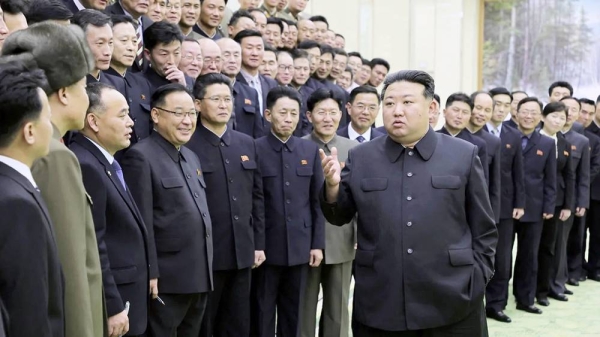
North Korea had told US officials more than once in recent years that it had about 200 sets of US war remains, although none was “already identified”
The 55 boxes were handed over at Wonsan, North Korea last Friday and flown aboard a US military transport plane to Osan air base in South Korea
WASHINGTON: When North Korea handed over 55 boxes of bones that it said are remains of American war dead, it provided a single military dog tag but no other information that could help US forensics experts determine their individual identities, a US defense official said Tuesday.
The official, who discussed previously undisclosed aspects of the remains issue on condition of anonymity, said it probably will take months if not years to fully determine individual identities from the remains, which have not yet been confirmed by US specialists to be those of American servicemen.
The official did not know details about the single dog tag, including the name on it, or whether it was even that of an American military member. During the Korean War, combat troops of 16 other United Nations member countries fought alongside US service members on behalf of South Korea. Some of them, including Australia, Belgium, France and the Philippines, have yet to recover some of their war dead from North Korea.
The 55 boxes were handed over at Wonsan, North Korea last Friday and flown aboard a US military transport plane to Osan air base in South Korea, where US officials catalogued the contents. After a repatriation ceremony at Osan on Wednesday, the remains will be flown to Hawaii where they will begin undergoing in-depth forensic analysis, in some cases using mitochondrial DNA profiles, at a Defense Department laboratory to attempt to establish individual identifications.
Defense Secretary Jim Mattis said last week that the return of the 55 boxes was a positive step but not a guarantee that the bones are American.
“We don’t know who’s in those boxes,” he said. He noted that some could turn out to be those of missing from other nations that fought in the Korean War. “They could go to Australia,” he said. “They have missing, France has missing, Americans have. There’s a whole lot of us. So, this is an international effort to bring closure for those families.”
Vice President Mike Pence, the son of a Korean War combat veteran, is scheduled to fly to Hawaii for a ceremony, which the military calls an “honorable carry ceremony,” marking the arrival of the remains on American soil at Joint Base Pearl Harbor-Hickam on Wednesday. This will mark a breakthrough in a long-stalled US effort to obtain war remains from North Korea, but officials say it is unlikely to produce quick satisfaction for any of the families of the nearly 7,700 US servicemen who are still listed as missing and unaccounted for from the 1950-53 Korean War.
North Korea provided the 55 boxes in a delayed fulfillment of a commitment its leader, Kim Jong Un, made to President Donald Trump at their Singapore summit on June 12. Although the point of the summit was for Trump to press Kim on giving up his nuclear weapons, their joint statement after the meeting included a single line on an agreement to recover “POW/MIA remains, including the immediate repatriation of those already identified.”
North Korea had told US officials more than once in recent years that it had about 200 sets of US war remains, although none was “already identified.” It remains unclear whether the boxes provided on July 27 include all of the bones North Korea has accumulated over the years. In the past, the North has provided bones that in some cases were not human or that were additional bones of US servicemen already identified from previously recovered remains.
The Pentagon estimates that of the approximately 7,700 US MIAs from the Korean War, about 5,300 are unaccounted for on North Korean soil. Many were buried in shallow graves near where they fell on the battlefield; some others died in North Korean or Chinese-run prisoner of war camps.
Efforts to recover remains in North Korea have been fraught with political and other obstacles since the war ended on July 27, 1953. Between 1990 and 1994, North Korea unilaterally handed over 208 caskets to the US, which turned out to contain remains of far more than 208 individuals, although forensics specialists thus far have established 181 identities. In addition, a series of US-North Korean recovery efforts, termed “joint field activities,” between 1996 and 2005 yielded 229 caskets of remains, of which 153 have been identified, according to the Pentagon.
The Trump administration, as part of the Singapore agreement, is pursuing discussions with North Korea on resuming those “field activities,” for which past administrations have paid millions of dollars in donated vehicles, equipment, food and cash at the request of the North Koreans. The US official who discussed aspects of the return of the 55 boxes on condition of anonymity said the US is considering the possibility of including South Korea in future searches for remains in North Korea. It’s not clear whether negotiations for such an arrangement are under way.
Richard Downes, whose father, Air Force Lt. Hal Downes, is among the Korean War missing, says this turnover of remains, having drawn worldwide attention, has the potential to put the US back on track to finding and eventually identifying many more.
Downes, 70, was 3½ when his father’s B-26 Invader went down on Jan. 13, 1952, northeast of Pyongyang, the North Korean capital. His family was left to wonder about his fate. Downes, now executive director of the Coalition of Families of Korean and Cold War POW/MIAs, which advocates for remains recovery, said he hopes the boxes that arrive in Hawaii on Wednesday prove to be a vanguard that leads to a fuller accounting for families.
“These 55 can set the stage for more to come,” Downes said.












